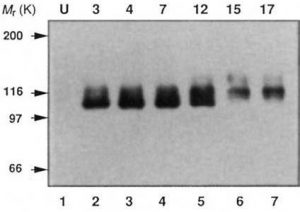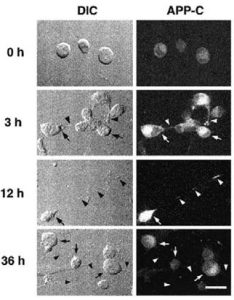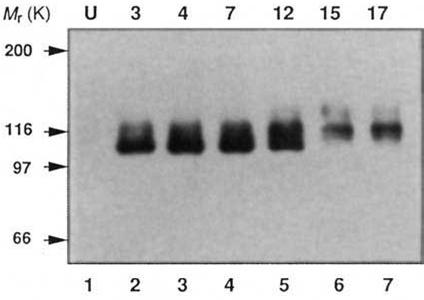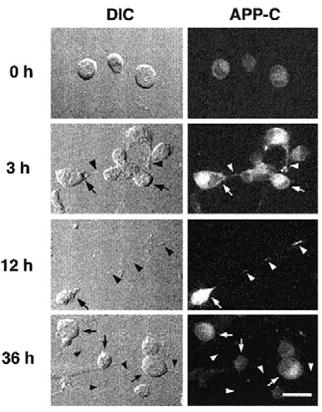Description
The Alzheimer amyloid precursor protein (APP) is an integral membrane protein expressed in many tissues and concentrated in the synapses of neurons. Its primary function is not known, though it has been implicated as a regulator of synapse formation and neural plasticity. APP is best known and most commonly studied as the precursor molecule whose proteolysis generates amyloid beta (Aβ), a 39 – 42 amino acid peptide whose amyloid fibrillar form is the primary component of amyloid plaques found in the brains of Alzheimer’s disease patients. Isoform APP695 lacking the protease inhibitor domain is the predominant form in neuronal tissues. An antibody (named AC1) against the C-terminus of human APP was raised in rabbit (ref. 2).
Applications
Western blot (dilution: 1/3,000)
Immunocytochemistry (dilution: 1/1,000)
Immunohistochemistry (dilution: 1/500)
Specification
Immunogen: Synthetic peptide corresponding to the C-terminus (aa 671-695) of human APP695
Specificity: Specific to human, mouse and rat APP
Form: Antiserum with 0.05% sodium azide
Storage: Shipped at 4°C and stored at -20°C
Data Link:
UniProtKB/Swiss-Prot P05067 (A4_HUMAN)
References:
Kang HG et al (1987) “The precursor of Alzheimer’s disease amyloid A4 protein resembles a cell-surface receptor” Nature 325: 733-736 PMID: 2881207
Yoshikawa K et al (2002) ”Degeneration in vitro of post-mitotic neurons overexpressing the Alzheimer amyloid protein precursor” Nature 359: 64-67 (1992) PMID: 1301020
Nishimura I et al (2002) “Cell death induced by a caspase-cleaved transmembrane fragment of the Alzheimer amyloid precursor protein” Cell Death Differ 9: 199-208 PMID: 11840170
Nishimura I et al (2003) “Up regulation and antiapoptotic role of endogenous Alzheimer amyloid precursor protein in dorsal root ganglion neurons” Exp Cell Res 286: 241-251 PMID: 12749853
Nishimura I et al (1998) “Degeneration in vivo of rat hippocampal neurons by wild-type Alzheimer amyloid precursor protein overexpressed by adenovirus-mediated gene transfer” J Neurosci 18: 2387-2396 PMID: 9502800

Fig.1 Endogenous expression of APP in mouse P19 cells during neural differentiation was analysed by Western blot using this antibody (ref. 2). lane1, undifferentiated P19 cells (U); lane 2, day 3; lane 3, day 4; lane 4, day 7; lane 5, day 12; lane 6, day 15; lane 7, day 17. APP species with 105-120K markedly increased during days 3-12, but declined thereafter. On the other hand, APP species with 115-130K were detected on day 15 and 17.

Fig.2 Immunocytochemistry for APP (ref. 4). Mouse dorsal root ganglion neurons were cultured in the presence of nerve growth factor (NGF), fixed at indicated time points, and immunostained for the C-terminus of APP with this antibody. Left panels are differential interference contrast images of the same fields. APP immunoreactivity was very low at 0 h but increased in neuronal somata (arrows), neurites (arrowheads) 3-12 h after NGF treatment, a period when neurites showed a marked outgrowth. APP immunoreactivity decreased at 36 h.




Reviews
There are no reviews yet.